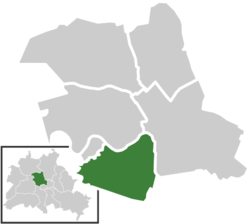Tiergarten (Berlin)
Tiergarten | |
|---|---|
 Panoramic view of the southern part of Tiergarten | |
| Coordinates: 52°31′00″N 13°22′00″E / 52.51667°N 13.36667°E | |
| Country | Germany |
| State | Berlin |
| City | Berlin |
| Borough | Mitte |
| Founded | 1861 |
| Area | |
| • Total | 5.17 km2 (2.00 sq mi) |
| Elevation | 52 m (171 ft) |
| Population (2020-12-31)[1] | |
| • Total | 14,940 |
| • Density | 2,900/km2 (7,500/sq mi) |
| Time zone | UTC+01:00 (CET) |
| • Summer (DST) | UTC+02:00 (CEST) |
| Postal codes | (nr. 0104) 10557, 10785, 10787 |
| Vehicle registration | B |
Tiergarten (German:
History
Historical notes


Once a hunting ground of the
On 15 January 1919 the socialist
The first Institut für Sexualwissenschaft (Institute for Sex Research) of Magnus Hirschfeld was situated at the former In den Zelten street, near the contemporary Haus der Kulturen der Welt, from 1919 until it was closed by the Nazis in 1933.[4]
A site next to the Tiergarten park is the former location of a villa at Tiergartenstrasse 4 where more than 60 Nazi bureaucrats and doctors worked in secret under the "T4" program to organize the mass murder of sanatorium and psychiatric hospital patients deemed unworthy to live.[5] The German national memorial to the people with disabilities systematically murdered by the Nazis was dedicated in 2014 in Berlin at that site.[6][5] Although the villa was destroyed, a Stolperstein set in the pavement on Tiergartenstraße marks its location and historic significance.
After 1944, the park was largely deforested because it served as a source of firewood for the devastated city. In 1945, the Soviet Union built a war memorial along the Straße des 17. Juni, the Tiergarten's main east–west artery, near the Brandenburg Gate. The Tiergarten itself became part of the British sector.
Tiergarten today

The locality houses many parliamentary and governmental institutions, among others the
The Brandenburg Gate and the Potsdamer Platz are situated on the eastern rim of the locality, which itself was the former frontier between East and West Berlin. Nearby is the Kulturforum stretching from the Berliner Philharmonie, a 1963 concert hall by architect Hans Scharoun and home of the Berlin Philharmonic orchestra to the Neue Nationalgalerie built by Ludwig Mies van der Rohe in 1968. In between are the neoclassical Saint Matthew Church, built in 1845 by Friedrich August Stüler, the Gemäldegalerie as well as the new branch of the Berlin State Library (Staatsbibliothek).
The adjacent area between the park and the Landwehrkanal is home to
The 1985 album Le Parc by Tangerine Dream contains a track titled Tiergarten. Rufus Wainwright also released a track titled Tiergarten as part of his 2007 album, Release the Stars.
Since 1987, the annual Berlin Marathon starts at Tiergarten near the Brandenburg Gate.
Between 1996 and 2003 and then in 2006, the Love Parade music festival took place at the Victory Column and Straße des 17. Juni. On 2 July 2005, the Live 8 concert, Berlin took place at the Victory Column.
On 24 July 2008, then-US presidential candidate Barack Obama spoke at the Victory Column in front of a crowd of over 200,000 people.[7]
Großer Tiergarten
Covering 210 hectares (520 acres), the "
Further reading
- Elizabeth Heekin Bartels, "Berlin's Tiergarten: Evolution of an Urban Park", Journal of Garden History (1982) 2#2 p143+
Notes
- ^ "Einwohnerinnen und Einwohner im Land Berlin am 31. Dezember 2020" (PDF). Amt für Statistik Berlin-Brandenburg. February 2021.
- ^ As still recalled in Tiergarten's coat of arms the meaning of 'Tier' used to be narrower in history than in modern German, originally describing 'game', i.e. non-domesticated animals hunted, and among them preferently the deer.
- ^ Uebersicht der neuen Eintheilung der Stadt Berlin in Stadtteile und Bezirke [Overview of the new division of the city of Berlin in neighborhoods and districts]. Grunert, Berlin 1884.
- ^ Friedrich Leyden: Gross-Berlin. Geographie der Weltstadt. Hirt, Breslau 1933 (darin: Entwicklung der Bevölkerungszahl in den historischen Stadtteilen von Alt-Berlin. S. 206).
- ^ a b "Berlin Dedicates Holocaust Memorial for Disabled - Global Agenda - News - Arutz Sheva". Arutz Sheva. 2 September 2014.
- ^ ABC News. "International News - World News - ABC News". ABC News.
- ^ Whitesides, John (26 July 2008). "Obama's foreign trip: Mission accomplished". Reuters. Retrieved 24 April 2022.





